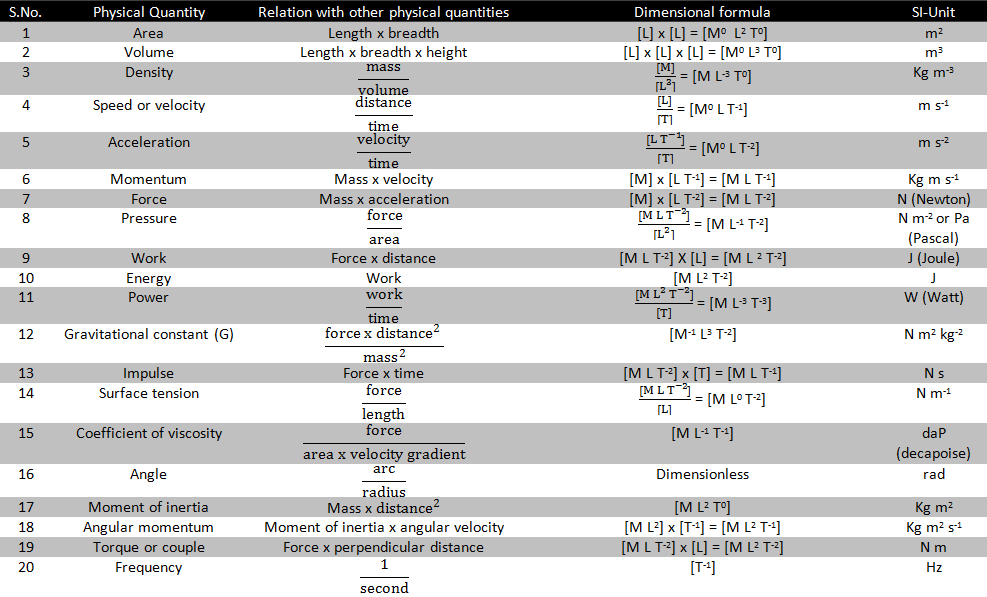IIT JEE Dimensional Formulae and Dimensional Equations
Table of Content |
Formulae of Dimensional
The expressions or formulae which tell us how and which of the fundamental quantities are present in a physical quantity are known as the Dimensional Formula of the Physical Quantity. Dimensional formulae also help in deriving units from one system to another. It has many real-life applications and is a basic aspect of units and measurements.
Suppose there is a physical quantity X which depends on base dimensions M (Mass), L (Length) and T (Time) with respective powers a, b and c, then its dimensional formula is represented as:
[MaLbTc]
A dimensional formula is always closed in a square bracket [ ]. Also, dimensional formulae of trigonometric, plane angle and solid angle are not defined as these quantities are dimensionless in nature.
Image 1: Dimensional Formula of some physical quantities.
-
Dimensional formula of Velocity is [M0LT-1]
-
Dimensional formula of Volume is [M0L3T0]
-
Dimensional formula of Force is [MLT-2]
-
Dimensional formula of Area is [M0L2T0]
-
Dimensional formula of Density is [ML-3T0]
Benefits of Dimensional Formulae
Image 2: Dimensions are used in describing a physical quantity in terms of above seven fundamental quantities.
Dimensional Formulae has the following advantages:
-
To check whether a formula is dimensionally correct or not
-
To convert units from one system to another
-
To derive relations between physical quantities based on their interdependence
-
Dimensional Formulae explain how every physical quantity can be expressed in terms of fundamental units
Limitations of Dimensional Formulae
Image 3: Dimensional Equations help in checking correctness of a equation
Besides having many advantages, dimensional formulae have some limitations too. They are as follows:
-
Dimensional Formulae become not defined in case of trigonometric, logarithmic and exponential functions, which means we can’t predict nature of quantities with these functions
-
Dimensional Formulae is limited to a number of physical quantities
-
They can’t be used to determine proportionality constants
-
Dimensional Formulae are limited to additional and subtraction only
Dimensional Equations
The equations obtained when we equal a physical quantity with its dimensional formulae are called Dimensional Equations. The dimensional equation helps in expressing physical quantities in terms of the base or fundamental quantities.
Suppose there’s a physical quantity Y which depends on base quantities M (mass), L (Length) and T (Time) and their raised powers are a, b and c, then dimensional formulae of physical quantity [Y] can be expressed as
[Y] = [MaLbTc]
Examples
-
Dimensional equation of velocity ‘v’ is given as [v] = [M0LT-1]
-
Dimensional equation of acceleration ‘a’ is given as [a] = [M0LT-2]
-
Dimensional equation of force ‘F’ is given as [F] = [MLT-2]
-
Dimensional equation of energy ‘E’ is give as [E] = [ML2T-2]
Image 4: We first simplify physical quantities and then write its dimensions.
Dimensional Equations are fundamental aspects of dimensional analysis and form the basic foundation of units and measurements as they help in simplifying physical quantities in terms of basic or fundamental quantities. The table below depicts some dimensional equations of some physical quantities for future reference.
Physical Quantity |
Dimensional Equation |
|
Force (F) |
[F] = [M L T-2] |
|
Power (P) |
[P] = [M L2 T-3] |
|
Velocity (v) |
[v] = [M L T-1] |
|
Density (D) |
[D] = [M L3 T0] |
|
Energy (E) |
[E] = [M L2 T-2] |
|
Pressure (P) |
[P] = [M L-1 T-2] |
|
Time Period of wave |
[T] = [M0L0 T-1] |
Watch this Video for more reference
More Readings
View courses by askIITians


Design classes One-on-One in your own way with Top IITians/Medical Professionals
Click Here Know More

Complete Self Study Package designed by Industry Leading Experts
Click Here Know More

Live 1-1 coding classes to unleash the Creator in your Child
Click Here Know More




